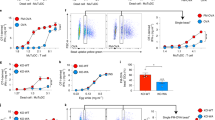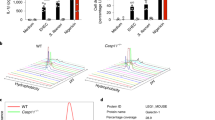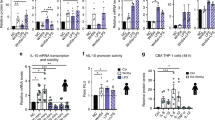Abstract
Macrophage-inducible C-type lectin (Mincle) is expressed mainly in macrophages and is induced after exposure to various stimuli and stresses. Here we show that Mincle selectively associated with the Fc receptor common γ-chain and activated macrophages to produce inflammatory cytokines and chemokines. Mincle-expressing cells were activated in the presence of dead cells, and we identified SAP130, a component of small nuclear ribonucloprotein, as a Mincle ligand that is released from dead cells. To investigate whether Mincle is required for normal responses to cell death in vivo, we induced thymocyte death by irradiating mice and found that transient infiltration of neutrophils into the thymus could be blocked by injection of Mincle-specific antibody. Our results suggest that Mincle is a receptor that senses nonhomeostatic cell death and thereby induces the production of inflammatory cytokines to drive the infiltration of neutrophils into damaged tissue.
This is a preview of subscription content, access via your institution
Access options
Subscribe to this journal
Receive 12 print issues and online access
$209.00 per year
only $17.42 per issue
Buy this article
- Purchase on Springer Link
- Instant access to full article PDF
Prices may be subject to local taxes which are calculated during checkout








Similar content being viewed by others
References
Fadok, V.A., Bratton, D.L. & Henson, P.M. Phagocyte receptors for apoptotic cells: recognition, uptake, and consequences. J. Clin. Invest. 108, 957–962 (2001).
Savill, J., Dransfield, I., Gregory, C. & Haslett, C. A blast from the past: clearance of apoptotic cells regulates immune responses. Nat. Rev. Immunol. 2, 965–975 (2002).
Lorimore, S.A., Coates, P.J., Scobie, G.E., Milne, G. & Wright, E.G. Inflammatory-type responses after exposure to ionizing radiation in vivo: a mechanism for radiation-induced bystander effects? Oncogene 20, 7085–7095 (2001).
Marshak-Rothstein, A. Toll-like receptors in systemic autoimmune disease. Nat. Rev. Immunol. 6, 823–835 (2006).
Zelensky, A.N. & Gready, J.E. The C-type lectin-like domain superfamily. FEBS J. 272, 6179–6217 (2005).
Robinson, M.J., Sancho, D., Slack, E.C., LeibundGut-Landmann, S. & Reis e Sousa, C. Myeloid C-type lectins in innate immunity. Nat. Immunol. 7, 1258–1265 (2006).
Ogden, C.A. et al. C1q and mannose binding lectin engagement of cell surface calreticulin and CD91 initiates macropinocytosis and uptake of apoptotic cells. J. Exp. Med. 194, 781–795 (2001).
Nauta, A.J. et al. Mannose-binding lectin engagement with late apoptotic and necrotic cells. Eur. J. Immunol. 33, 2853–2863 (2003).
Delneste, Y. et al. Involvement of LOX-1 in dendritic cell-mediated antigen cross-presentation. Immunity 17, 353–362 (2002).
Yuita, H. et al. Retardation of removal of radiation-induced apoptotic cells in developing neural tubes in macrophage galactose-type C-type lectin-1-deficient mouse embryos. Glycobiology 15, 1368–1375 (2005).
Rogers, N.C. et al. Syk-dependent cytokine induction by Dectin-1 reveals a novel pattern recognition pathway for C type lectins. Immunity 22, 507–517 (2005).
Fuller, G.L. et al. The C-type lectin receptors CLEC-2 and Dectin-1, but not DC-SIGN, signal via a novel YXXL-dependent signaling cascade. J. Biol. Chem. 282, 12397–12409 (2007).
Kanazawa, N., Tashiro, K., Inaba, K. & Miyachi, Y. Dendritic cell immunoactivating receptor, a novel C-type lectin immunoreceptor, acts as an activating receptor through association with Fc receptor gamma chain. J. Biol. Chem. 278, 32645–32652 (2003).
Bakker, A.B., Baker, E., Sutherland, G.R., Phillips, J.H. & Lanier, L.L. Myeloid DAP12-associating lectin (MDL)-1 is a cell surface receptor involved in the activation of myeloid cells. Proc. Natl. Acad. Sci. USA 96, 9792–9796 (1999).
Sato, K. et al. Dectin-2 is a pattern recognition receptor for fungi that couples with the Fc receptor γ chain to induce innate immune responses. J. Biol. Chem. 281, 38854–38866 (2006).
Flornes, L.M. et al. Identification of lectin-like receptors expressed by antigen presenting cells and neutrophils and their mapping to a novel gene complex. Immunogenetics 56, 506–517 (2004).
Matsumoto, M. et al. A novel LPS-inducible C-type lectin is a transcriptional target of NF-IL6 in macrophages. J. Immunol. 163, 5039–5048 (1999).
Gross, O. et al. Card9 controls a non-TLR signalling pathway for innate anti-fungal immunity. Nature 442, 651–656 (2006).
Hsu, Y.M. et al. The adaptor protein CARD9 is required for innate immune responses to intracellular pathogens. Nat. Immunol. 8, 198–205 (2007).
Hara, H. et al. The adaptor protein CARD9 is essential for the activation of myeloid cells through ITAM-associated and Toll-like receptors. Nat. Immunol. 8, 619–629 (2007).
Bjorkbacka, H. et al. The induction of macrophage gene expression by LPS predominantly utilizes Myd88-independent signaling cascades. Physiol. Genomics 19, 319–330 (2004).
Ohtsuka, M. et al. NFAM1, an immunoreceptor tyrosine-based activation motif-bearing molecule that regulates B cell development and signaling. Proc. Natl. Acad. Sci. USA 101, 8126–8131 (2004).
Drickamer, K. Engineering galactose-binding activity into a C-type mannose-binding protein. Nature 360, 183–186 (1992).
Das, B.K. et al. Characterization of a protein complex containing spliceosomal proteins SAPs 49, 130, 145, and 155. Mol. Cell. Biol. 19, 6796–6802 (1999).
Brand, M. et al. UV-damaged DNA-binding protein in the TFTC complex links DNA damage recognition to nucleosome acetylation. EMBO J. 20, 3187–3196 (2001).
Lotze, M.T. & Tracey, K.J. High-mobility group box 1 protein (HMGB1): nuclear weapon in the immune arsenal. Nat. Rev. Immunol. 5, 331–342 (2005).
Caricchio, R., McPhie, L. & Cohen, P.L. Ultraviolet B radiation-induced cell death: critical role of ultraviolet dose in inflammation and lupus autoantigen redistribution. J. Immunol. 171, 5778–5786 (2003).
Li, J. et al. Impaired phagocytosis in caveolin-1 deficient macrophages. Cell Cycle 4, 1599–1607 (2005).
Uchimura, E., Watanabe, N., Niwa, O., Muto, M. & Kobayashi, Y. Transient infiltration of neutrophils into the thymus in association with apoptosis induced by whole-body X-irradiation. J. Leukoc. Biol. 67, 780–784 (2000).
Yoshida, H. et al. Apaf1 is required for mitochondrial pathways of apoptosis and brain development. Cell 94, 739–750 (1998).
Iyoda, T., Nagata, K., Akashi, M. & Kobayashi, Y. Neutrophils accelerate macrophage-mediated digestion of apoptotic cells in vivo as well as in vitro. J. Immunol. 175, 3475–3483 (2005).
Oka, K. et al. Lectin-like oxidized low-density lipoprotein receptor 1 mediates phagocytosis of aged/apoptotic cells in endothelial cells. Proc. Natl. Acad. Sci. USA 95, 9535–9540 (1998).
Green, R.S. et al. Mammalian N-glycan branching protects against innate immune self-recognition and inflammation in autoimmune disease pathogenesis. Immunity 27, 308–320 (2007).
Franz, S. et al. Lectins detect changes of the glycosylation status of plasma membrane constituents during late apoptosis. Cytometry A 69, 230–239 (2006).
Lee, S.J. et al. Mannose receptor-mediated regulation of serum glycoprotein homeostasis. Science 295, 1898–1901 (2002).
Akira, S. & Kishimoto, T. NF-IL6 and NF-κB in cytokine gene regulation. Adv. Immunol. 65, 1–46 (1997).
Nathan, C. Neutrophils and immunity: challenges and opportunities. Nat. Rev. Immunol. 6, 173–182 (2006).
Nakamura, N. et al. Isolation and expression profiling of genes upregulated in bone marrow-derived mononuclear cells of rheumatoid arthritis patients. DNA Res. 13, 169–183 (2006).
Ribbhammar, U. et al. High resolution mapping of an arthritis susceptibility locus on rat chromosome 4, and characterization of regulated phenotypes. Hum. Mol. Genet. 12, 2087–2096 (2003).
Martinon, F., Petrilli, V., Mayor, A., Tardivel, A. & Tschopp, J. Gout-associated uric acid crystals activate the NALP3 inflammasome. Nature 440, 237–241 (2006).
Kim, H.S. et al. Toll-like receptor 2 senses β-cell death and contributes to the initiation of autoimmune diabetes. Immunity 27, 321–333 (2007).
Mimori, T., Hinterberger, M., Pettersson, I. & Steitz, J.A. Autoantibodies to the U2 small nuclear ribonucleoprotein in a patient with scleroderma-polymyositis overlap syndrome. J. Biol. Chem. 259, 560–565 (1984).
Savarese, E. et al. U1 small nuclear ribonucleoprotein immune complexes induce type I interferon in plasmacytoid dendritic cells through TLR7. Blood 107, 3229–3234 (2006).
Vollmer, J. et al. Immune stimulation mediated by autoantigen binding sites within small nuclear RNAs involves Toll-like receptors 7 and 8. J. Exp. Med. 202, 1575–1585 (2005).
Hamerman, J.A., Tchao, N.K., Lowell, C.A. & Lanier, L.L. Enhanced Toll-like receptor responses in the absence of signaling adaptor DAP12. Nat. Immunol. 6, 579–586 (2005).
Cao, W. et al. Plasmacytoid dendritic cell-specific receptor ILT7-FcεRIγ inhibits Toll-like receptor-induced interferon production. J. Exp. Med. 203, 1399–1405 (2006).
Wells, C.A. et al. The macrophage-inducible C-type lectin, mincle, is an essential component of the innate immune response to Candida albicans. J. Immunol. 180, 7404–7413 (2008).
Park, S.Y. et al. Resistance of Fc receptor-deficient mice to fatal glomerulonephritis. J. Clin. Invest. 102, 1229–1238 (1998).
Hazenbos, W.L. et al. Impaired IgG-dependent anaphylaxis and Arthus reaction in FcγRIII (CD16) deficient mice. Immunity 5, 181–188 (1996).
Ioan-Facsinay, A. et al. FcgammaRI (CD64) contributes substantially to severity of arthritis, hypersensitivity responses, and protection from bacterial infection. Immunity 16, 391–402 (2002).
Yamasaki, S. et al. Mechanistic basis of pre–T cell receptor–mediated autonomous signaling critical for thymocyte development. Nat. Immunol. 7, 67–75 (2006).
Shi, Y., Evans, J.E. & Rock, K.L. Molecular identification of a danger signal that alerts the immune system to dying cells. Nature 425, 516–521 (2003).
Acknowledgements
We thank S. Akira (Osaka University) for MyD88-deficient mice on a B6 background; J.S. Verbeek (Leiden University) for FcγRI-deficient and FcγRIII-deficient mice; S. Nagata (Kyoto University) for 'leucine-zippered' FasL; S. Seki, T. Aoyama, A. Iwamatsu, Y. Tatsumi and T. Ishikawa for technical assistance; T. Kaisho, M. Tanaka, Y. Miyake, H. Ohno, H. Yoshida, S. Ishido, T. Sugiyama, T. Imanishi, O. Takeuchi and T. Iwahara for discussions; and H. Yamaguchi for secretarial assistance.
Author information
Authors and Affiliations
Contributions
S.Y. designed experiments; E.I., M.S. and S.Y. did experiments; S.Y. wrote the paper; H.H. provided knockout mice; K.O. did molecular modeling; and T.S. supervised the research.
Corresponding authors
Supplementary information
Supplementary Text and Figures
Supplementary Figures 1–9 and Supplementary Table 1 (PDF 453 kb)
Rights and permissions
About this article
Cite this article
Yamasaki, S., Ishikawa, E., Sakuma, M. et al. Mincle is an ITAM-coupled activating receptor that senses damaged cells. Nat Immunol 9, 1179–1188 (2008). https://doi.org/10.1038/ni.1651
Received:
Accepted:
Published:
Issue Date:
DOI: https://doi.org/10.1038/ni.1651
This article is cited by
-
Mesenchymal stem cells transplantation combined with IronQ attenuates ICH-induced inflammation response via Mincle/syk signaling pathway
Stem Cell Research & Therapy (2023)
-
Macrophages mediate psoriasis via Mincle-dependent mechanism in mice
Cell Death Discovery (2023)
-
Macrophages in cardiac remodelling after myocardial infarction
Nature Reviews Cardiology (2023)
-
Aryl-functionalised α,α′-Trehalose 6,6′-Glycolipid Induces Mincle-independent Pyroptotic Cell Death
Inflammation (2023)
-
Heat-Killed Levilactobacillus brevis as a Candidate Postbiotics Through Immunostimulation Mediated by Macrophage-Inducible C-Type Lectin
Probiotics and Antimicrobial Proteins (2023)



